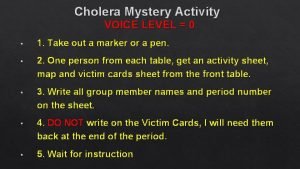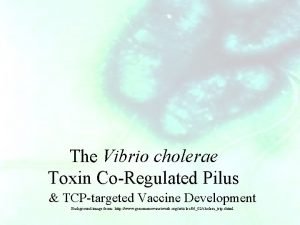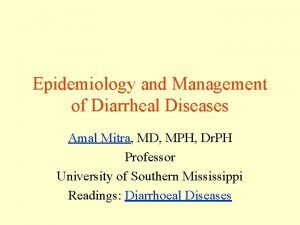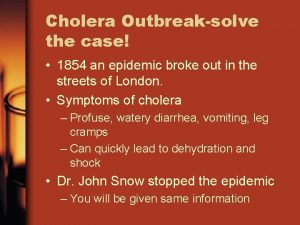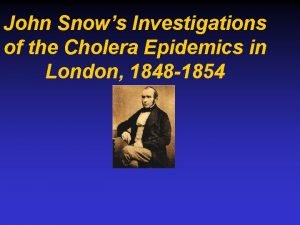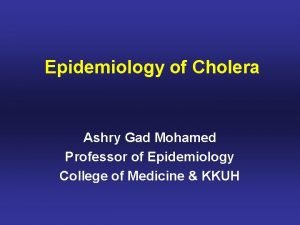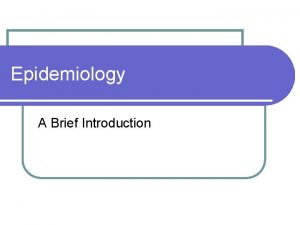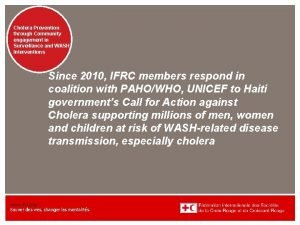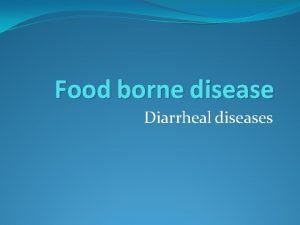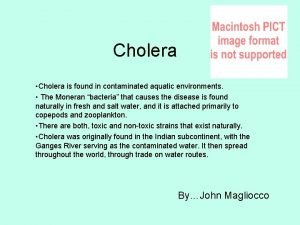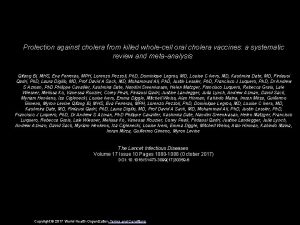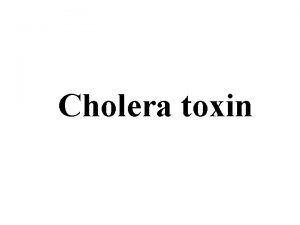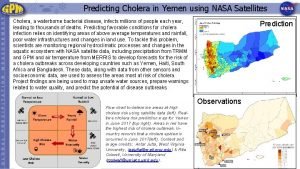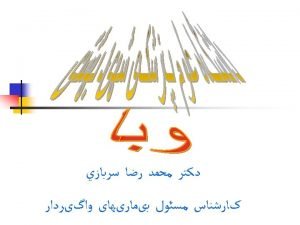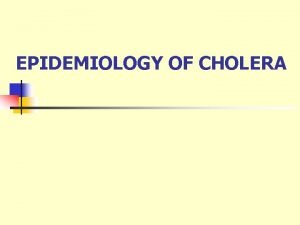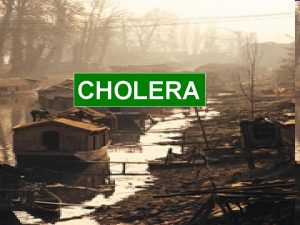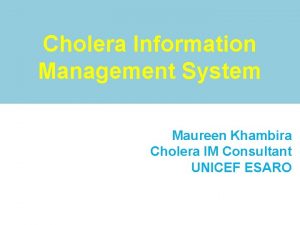Cholera Mystery Activity VOICE LEVEL 0 1 Take












- Slides: 12

Cholera Mystery Activity VOICE LEVEL = 0 § 1. Take out a marker or a pen. § 2. One person from each table, get an activity sheet, map and victim cards sheet from the front table. § 3. Write all group member names and period number on the sheet. § 4. DO NOT write on the Victim Cards, I will need them back at the end of the period. § 5. Wait for instruction

Dr. John Snow Activity - Introduction In 1854 a cholera epidemic broke out in the slums of London. Cholera is an acute diarrhea disease that can kill within hours if left untreated. It takes between 12 hours and 5 days for a person to show symptoms. Researchers have estimated that each year there are 1. 3 million to 4. 0 million cases of cholera, and 21 000 to 143 000 deaths worldwide due to cholera (1). Most of those infected will have no or mild symptoms, and can be successfully treated with oral rehydration solution. Severe cases will need rapid treatment with intravenous fluids and antibiotics.

Introduction & Objective Throughout history Cholera killed millions of people, and hundreds died in the 1854 epidemic. One man, Dr. John Snow, discovered the source and stopped the epidemic. You will be given the same information that Dr. Snow possessed and will try to solve the mysterious epidemic.

Step 1: Review Victim Cards & Map Each group will be given a Broad Street Area Map, a set of Victim Cards, and will need a marker or pen. You will have 20 minutes to fill out the map, study the Victim Cards and write down all common characteristics on you activity sheet.

Map If you have not already done so, start marking locations of victims on the map…

Step 2: Draw a Conclusion After reviewing all the victim cards, your group will come up with a conclusion and outline it on the activity sheet.

Step 3: Revise Now, one at a time, I will dismiss each group to read the Clue Cards at each station. The cards reveal additional information uncovered by Dr. Snow. Do not discuss your ideas with other groups! As more information is given through the Clue Cards, you will either confirm or revise your original conclusions.

Turn in Your Completed Activity Sheet Turn in your activity sheet to the teacher.

Critical Thinking - India Epidemic The disease actually broke out in India prior to the London epidemic. Discuss with your groups, how the disease might have traveled to the Broad Street pump. Be ready to share with the class.

Class Discussion In conclusion, Cholera bacterium travels through untreated water contaminated by human or animal feces. Cholera is spread by sharing contaminated water or by eating contaminated food. Since the body does not produce a lasting immunity against the bacterium, the disease can be contracted more than once. Water treatment can prevent outbreaks of waterborne diseases such as cholera. Some students who have traveled abroad may have received a cholera vaccination - Why was this necessary?

Discussion Answers Some students who have traveled abroad may have received a cholera vaccination - Why was this necessary? The long-term solution for cholera control lies in economic development and universal access to safe drinking water and adequate sanitation. Actions targeting environmental conditions include the implementation of adapted long-term sustainable WASH solutions to ensure use of safe water, basic sanitation and good hygiene practices to populations most at risk of cholera. In addition to cholera, such interventions prevent a wide range of other water-borne illnesses, as well as contributing to achieving goals related to poverty, malnutrition, and education. Many of these interventions require substantial long-term investments and continued maintenance, making them difficult to fund and sustain by less developed countries where the interventions are most needed. Cholera has been absent from the Western Hemisphere for most of the 20 th Century Nonetheless, health officials warn that the United States could experience outbreaks of choler and other waterborne diseases. So, because these students may have been traveling to destinations that do no have the same standards of water treatment as we do here in the United States. Some countries do not have the same technology or means to provide clean water as we do here in the United States.

Dr. John Snow’s Discovery Dr. John Snow is regarded as one of the founding fathers of modern epidemiology. As London suffered a series of cholera outbreaks during the mid-19 th century, Snow theorized that cholera reproduced in the human body and was spread through contaminated water. This contradicted the prevailing theory that diseases were spread by "miasma" in the air. London's water supply system consisted of shallow public wells where people could pump their own water to carry home, and about a dozen water utilities that drew water from the Thames to supply a jumble of water lines to more upscale houses. London's sewage system was even more ad hoc: privies emptied into cesspools or cellars more often than directly into sewer pipes. So the pervasive stench of animal and human feces combined with rotting garbage made the miasma theory of disease seem very plausible. Disease was more prevalent in lower-class neighborhoods because they stank more, and because the supposed moral depravity of poor people weakened their constitutions and made them more vulnerable to disease. The September 1854 cholera outbreak was centered in the Soho district, close to Snow's house. Snow mapped the 13 public wells and all the known cholera deaths around Soho, and noted the spatial clustering of cases around one particular water pump on the southwest corner of the intersection of Broad (now Broadwick) Street and Cambridge (now Lexington) Street. He examined water samples from various wells under a microscope, and confirmed the presence of an unknown bacterium in the Broad Street samples. Despite strong skepticism from the local authorities, he had the pump handle removed from the Broad Street pump and the outbreak quickly subsided.
